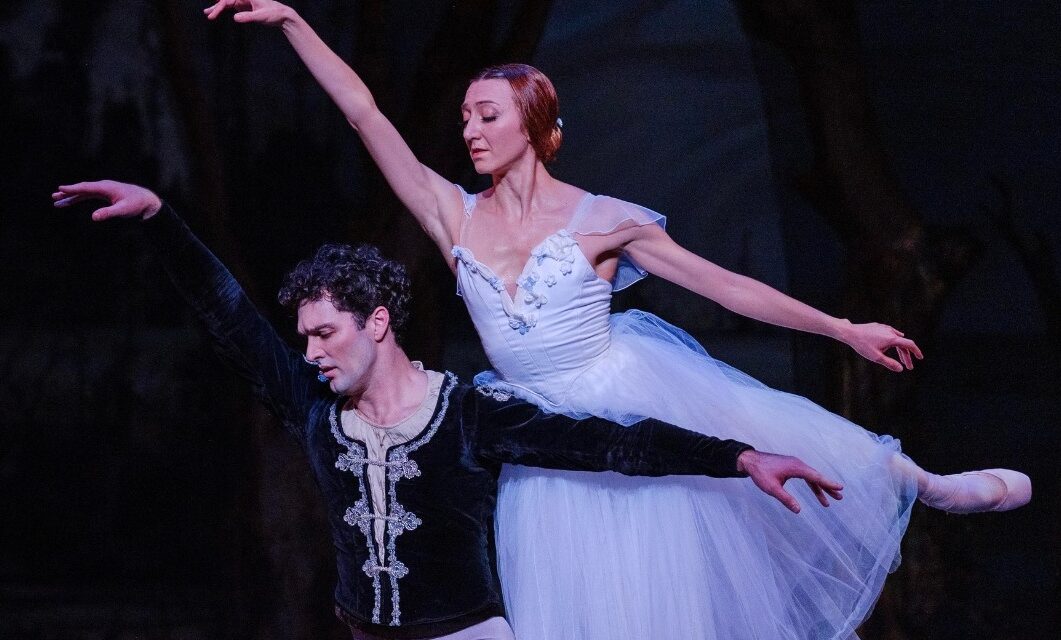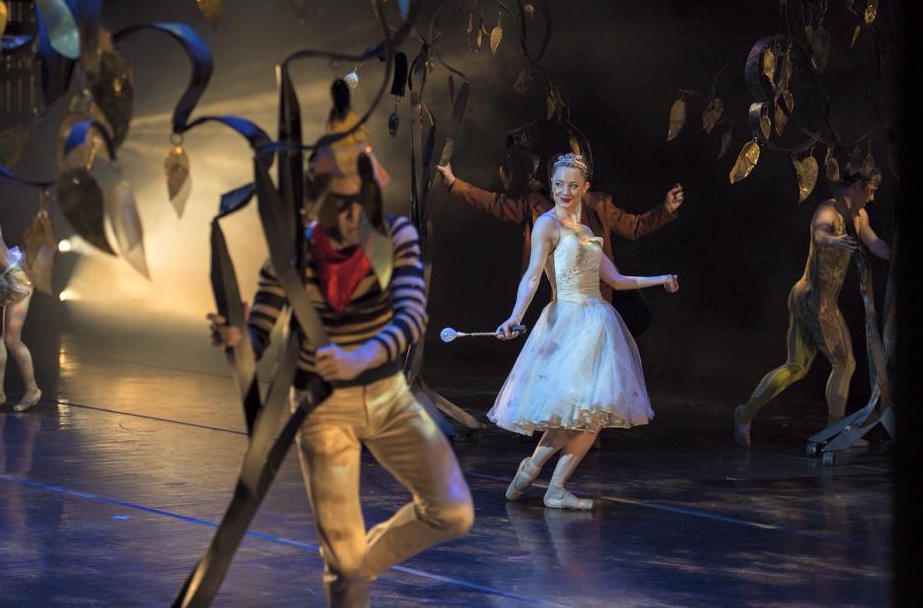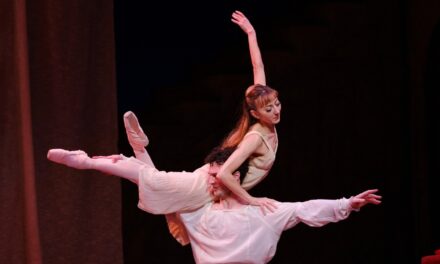Mark Krieger & Natalia Ashikhmina in Giselle. Photo: Josh Mauser
Giselle
Choreography by Jean Coralli & Jules Perrot
Music by Adolphe Adam
A review by Amberly K. Simpson
Entire contents are copyright © 2023 by Amberly K. Simpson
The Louisville Ballet opened its second production as part of its Season of the Commonwealth with Giselle, a Romantic Era ballet often considered the epitome of Romanticism. Though the Louisville Ballet had originally stated its intent to do a reimagining of Giselle, efforts to reduce organizational costs motivated them to instead restage their original production, one that has been gracing Louisville’s stages since 1961. This allowed them to utilize their original sets and costumes, as well as to build off of the foundations of an already tried and true production, and the results were spectacular. From the moment the curtain came up, I found myself transported in time and space with a production that perfectly captured the Romantic Ballet era with its pastoral/folk setting, supernatural characters and nature themes, and emphasis on emotion-based storytelling (often with tragic endings).
Helen Daigle, though taking on a minor role as Giselle’s mother, Berthe, consistently drew my eye with her ability to bring intention and depth to even the most gestural of movements. The moment when she warns Giselle to be mindful of her health is chilling and remarkably poignant in its simplicity.
Additionally, Aleksandr Schroeder shined in his pas de deux and feature roles during the harvest celebration. Even from a distance, he has a distinct authenticity when he performs. The pure delight that he exudes is infectious and captivating!
Finally, I want to especially commend Natalia Ashikhmina on her performance in the titular role. The physicality of the role of Giselle is undeniable, not only onstage where the performance is incredibly athletic, but even offstage, such as in Act II where she is darting from wing to wing to represent the haunting of a wilis. The performative range that it requires is immense, going from lighthearted innocence and joy to being utterly distraught and full of rage, to sorrow with a heavy dose of fierce protectiveness. Giselle’s heartbreak scene and descent into grief and madness is a perfect example as there is not only a stark shift in character from previous scenes in Act I but also the sheer emotion only escalates as the scene goes on, eventually ending in her demise. Ashikhmina did a truly outstanding job in this role; it was as if the role was made exclusively for her!
Individual performances aside, the Wilis are, hands down, the true stars of this production, featuring some of the most visually spectacular ensemble numbers in the show. These numbers are not only choreographically brilliant but their large ensemble cast and voluminous costumes help to fill the stage with an ethereal magic. But, of course, this light, airy, and mystical appearance is in stark contrast to their true nature as cold-blooded, vengeful murderers! The Wilis are meant to represent young women who died of broken hearts after their lovers betrayed them before their wedding day. As such, these mysterious forest creatures take revenge upon men they find in the forest at night by forcing them to dance until they ultimately perish. Even without their iconic costumes, impeccable choreographic composition, and perfectly precise execution, the Wilis are just a downright fascinating character in and of themselves! I would have been fully satisfied to see a production where they were the central characters.
As a whole, The Louisville Ballet’s Giselle was 10/10 on artistic execution. The dancers were impeccable, the sets were breathtaking, the costuming was magical, and the lighting helped to perfectly align every moment. In terms of performance, it was a remarkable success!
Irrefutable production value and performance aside, we need to talk about the elephant in the room: the story itself.
It’s no mystery that The Louisville Ballet’s new executive leadership has been taking big action to reduce costs within the organization. As a whole, I think they have been making a lot of very smart and calculated choices in this regard under Leslie Smart’s leadership. Bravo to that! However, one of the cost-cutting decisions that was made was to abandon the original plan that had been established under former Artistic Director Robert Curran to reimagine the ballet as a more locally-oriented production set in Germantown. As much as I would have loved to see this reimagining, I think the decision to stick with their original was wise both financially and artistically. My only qualms were that two major sacrifices were made: once again, the production had no clear connection to their “Season of the Commonwealth,” and the opportunity to fix the outdated and problematic messaging of the original story was ignored.
To be honest, I am a bit shocked that, as a predominantly woman-run organization with a student population composed of predominantly young girls and women, The Louisville Ballet felt okay with reproducing this story. The first ten minutes of the show consist of multiple attempts by a man (Albrecht) to kiss a young woman (Giselle) who has repeatedly told him ‘no,’ physically pushed him away, and made it explicitly clear that she is not interested in his advances. And, let’s be clear, it’s not just implied that he wants to kiss her, he very literally tries to kiss her over and over again. His advances are incredibly physical. This is especially creepy due to the multiple layers of power dynamics at play where Albrecht is not only physically larger than Giselle and can clearly overpower her, but also his social status where he is a nobleman and she is a peasant.
To make matters even more icky, he is also manipulating her, first by pretending to be a peasant himself, but also in not revealing the fact that he is engaged. Furthermore, while he is advancing upon her, Albrecht takes the flower that Giselle had used to explain that “she loves him not,” pulls off a petal, and gaslights her into thinking she miscounted.
The other men in this production aren’t exactly what I would call model gentlemen either. Upon seeing Giselle and Albrecht together, Hilarion (who also has feelings for Giselle) storms in and gets angry at HER instead of coming to her defense against this aggressive and deceitful stranger.
All of these actions take place within the first 10-15 minutes of the production, and, ultimately, Giselle dies of a broken heart at the end of Act I after Albrecht’s deceit is revealed. Act II has all the opportunity in the world to present a narrative that gives its titular character more agency, but, unfortunately, it never does. She is buried in unhallowed ground with an unmarked grave, for even though Albrecht is the one who committed wrongdoing, Giselle is who carries every one of the consequences of his actions. Even when the Wilis try to kill Albrecht, Giselle intervenes and prevents his death, allowing his life to carry on while she remains a woman dishonored.
Watching this narrative unfold onstage, where many parts were wrought with outdated tropes and representations of women, and, at other moments, downright inappropriate and uncomfortable to witness, I couldn’t help but wonder if anyone had considered what it was communicating to every woman and young girl in the audience.
There is a reason Disney has started telling different narratives in recent years. Whether or not we want this, the truth is that we, as artists and arts organizations, have a responsibility to our audiences. Just because a story ballet is dance and exists on a slightly higher level of abstraction than a movie or play, for example, doesn’t mean that we should ignore problematic narratives, the same way that you wouldn’t ignore the quality of a cake’s sponge just because it has an intricate frosting display on top. Ballet movement is beautiful, but beauty should not be considered a distraction from the substance of the work.
It would be one thing if the story was problematic and there was some level of acknowledgment of this, but the program, show advertisement, and other published materials, unfortunately, deliver quite the opposite, describing it as “a story of eternal love that transcends time and space.” Additionally, they state that it “takes us on a journey through the depths of betrayal, forgiveness, and redemption.” I can certainly see the betrayal and forgiveness component, but Albrecht does absolutely nothing in the realms of redemption other than mourning at her graveside. Without true redemption, forgiveness holds little meaning. Without consequences, there is no growth.
Some of these concerns can easily be brushed off as byproducts of the time period the piece originated from. Sure, this is certainly true with things like the rapid romance (meet in the morning, dead of a broken heart by afternoon tea time) and the presence of mystical forest creatures, but the most alarming aspects of this narrative were choreographic choices, not crucial elements of the plot that were beyond modification in the context of retaining a classic. There was, for example, no reason for Albrecht to continually attempt to kiss Giselle despite her refusal. Plain and simple, that isn’t courting someone. That is, at best, not respecting their boundaries, and at worst violating her. The fact that she eventually gives in does not change that. Indeed, it draws into question whether love is even possible in this story at all.
It’s worth noting as well that I’m not the first person to find problems in this narrative. There is a pretty wide body of literary criticism that exists on this very story (and for many of the same reasons I have cited), and many other dance organizations who have staged this production have modified or reimagined it completely to avoid this. For example, Akram Khan’s reimagining of Giselle. Just because a story is so old that we’ve accepted it as canon doesn’t mean that we don’t have an obligation to continue to evaluate its substance, especially if we are elevating that story, validating and legitimizing it in front of thousands of spectators’ eyes.
As the audience filtered out of the theatre, I saw an adult turn to a girl who could not have been more than six years old (whom they did not know, by the way) and ask her “Did you like that?” I still cringe thinking about it…they had no idea the nuances of the question they were asking.
Oftentimes, people get caught up in the beauty of dance and they forget that the movement and the stories have meaning. As such, I think it is easy for audiences, especially those who have relegated dance to a mere decorative frill, to forget that it’s not just the wow factor of the movement that matters, but what is being communicated by the movement. Whether audiences realized it or not, a lot of things were legitimized by this story. Patriarchy. Loss of female agency. Women bear the consequences of men’s actions. The image of the ideal woman as virginal yet desirable, and fragile. Death by broken heart (life ends without the validation of a man) Etc.
I can hear my mother’s voice in my head as I write this, complaining of me hyper-analyzing, telling me “It’s just a story, just enjoy it.” But the truth is that things are never just a story. Stories communicate our values, our beliefs, and our culture. Stories are a mirror and a magnifying glass. While the production, from the perspective of artistic execution, was stunning on every level, I still can’t shake the cognitive dissonance that the story itself produced. I hope that, in the future, the ballet will make greater efforts to put the same level of excellence, vetting, and artistic scrutiny into their stories, and the substance of their work, as they do the face value of their work.
Principals Natalia Ashikhmina, Helen Daigle, Lexa Daniels, Caleb Emory, Mark Krieger, Daniel Scofield, David Senti
Giselle
November 10-13, 2023
Louisville Ballet
The Brown Theatre
West Broadway
Louisville, KY 40202
Amberly M. Simpson is a Choreographer, Dancer, and Dance Educator/Advocate originally from Glendale, California. She specializes in Modern, Post-Modern, and Contemporary Dance forms, creating work that is often interdisciplinary in nature to provide commentary on social issues and the human condition. By day, she is the Dance Director and Musical Theatre Co-Director at Noe Middle School, but by night she serves as the Artistic Director of Ambo Dance Theatre. Amberly’s work has been presented at venues such as the American Dance Festival Movies by Movers, the Going Dutch Festival, the Midwest Regional Alternative Dance Festival, and Princeton Research Day where her collaboration with Dr. David Vartanyan received the Impact Award. In 2019, she was honored as one of the Hadley Creatives through the Community Foundation of Louisville, and in 2022 she worked alongside her Dance colleagues in the Jefferson County Public Schools to launch the first-ever All County Dance program for the state of Kentucky.





